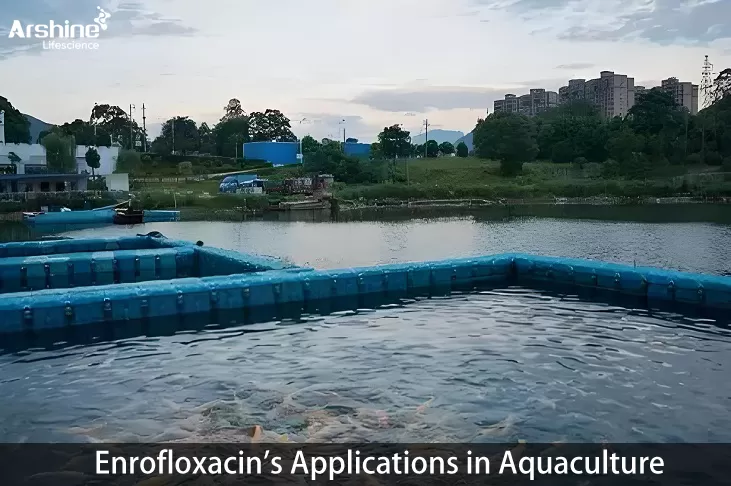

Enrofloxacin, as a third-generation fluoroquinolone drug specifically for animals, has played a significant role in aquaculture since its introduction due to its unique antibacterial mechanism and wide range of applications. This article will comprehensively elaborate on the important role of enrofloxacin in aquaculture from several aspects: basic characteristics, pharmacological effects, specific applications in aquaculture, safety, and rational use.
I. Basic Characteristics of Enrofloxacin
Enrofloxacin, chemically known as ethyl cyclopropyl fluoroquinolone or ethyl cyclopropyl ciprofloxacin, was developed by Bayer AG in Germany and first marketed in New Zealand in 1987. China successfully developed and produced it in 1993, and it quickly became one of the important antibacterial drugs in aquaculture. Enrofloxacin is a light yellow or pale yellow crystalline powder, insoluble in water but easily soluble in sodium hydroxide solution, methanol, cyanomethane, and other organic solvents. With its long half-life, wide distribution, good absorption, and broad-spectrum antibacterial properties in aquatic animals, it is widely used for the prevention and treatment of infectious diseases in aquaculture.
II. Pharmacological Effects of Enrofloxacin
The main mechanism of enrofloxacin is to directly act on the nucleus of pathogens, blocking the "gyrase" required for DNA (deoxyribonucleic acid) replication, thereby inhibiting bacterial metabolism and reproduction at the core. This unique antibacterial method enables enrofloxacin to rapidly and effectively kill pathogenic bacteria, including stubborn mycoplasma. Additionally, enrofloxacin has an extremely broad antibacterial spectrum, with strong bactericidal effects against both Gram-positive and Gram-negative bacteria, particularly showing more significant effects against fixed mycoplasma.
III. Specific Applications of Enrofloxacin in Aquaculture
Enrofloxacin is widely used in aquaculture, primarily for treating various diseases caused by bacteria. For example, it exhibits excellent efficacy against common bacterial diseases in aquatic animals, such as fulminant hemorrhagic disease, hemorrhagic septicemia, bacterial gill rot, print disease, enteritis, red fin disease, red body disease, ulcers, and Edwardsiella disease. Enrofloxacin is especially effective in treating gill rot syndrome.
In practical applications, enrofloxacin is usually administered by mixing it into feed or oral administration. For aquatic feed, 200g of enrofloxacin can be added per 1000kg of feed, used continuously for 5-7 days, with the dose doubled for severe cases and halved for prevention. This method of administration is simple and convenient, ensuring uniform distribution and effective absorption of the drug in fish.
IV. Safety of Enrofloxacin
The safety of enrofloxacin in aquaculture has been widely recognized. Studies show that the metabolism of enrofloxacin in fish and other aquatic animals mainly involves the removal of the ethyl group to form ciprofloxacin, a process that causes minimal damage to the organism. Moreover, enrofloxacin at therapeutic doses does not reduce the organism's immunity or disease resistance, providing strong support for its widespread use in aquaculture.
However, it is important to note that the residue of enrofloxacin in aquatic animals requires high attention. To ensure the safety of aquatic products, it is essential to strictly follow the prescribed usage methods and dosages and set reasonable withdrawal periods. In China, the withdrawal period for enrofloxacin in aquaculture is usually expressed in degree-days, i.e., the product of water temperature (degrees) and time (days). The withdrawal period varies depending on the specific aquatic animal species and farming conditions.
V. Rational Use of Enrofloxacin
To ensure the rational use of enrofloxacin in aquaculture, the following aspects must be considered:
Accurate diagnosis: Before using enrofloxacin, the disease type and pathogen must be clearly diagnosed to select the appropriate drug and dosage.
Standardized medication: Strictly follow veterinary drug use regulations and pharmacokinetic parameters of farmed animals to avoid overdose or misuse.
Controlled withdrawal period: Set a reasonable withdrawal period based on specific conditions to ensure drug residues in aquatic products are below the maximum allowable limit before market.
Enhanced monitoring: Regularly monitor drug residues in farming water and animals to ensure the safety of aquatic products.
Integrated prevention and control: In addition to drug treatment, combine other prevention measures, such as improving farming environments and management, to enhance overall aquaculture efficiency.
VI. Conclusion
As a highly effective and broad-spectrum antibacterial drug, enrofloxacin plays a vital role in aquaculture. Its rational use can effectively control bacterial diseases in aquatic animals, improving farming efficiency and product quality. However, we must also be aware of potential issues and challenges, such as drug residues and resistance. Therefore, future research and applications should focus on exploring and innovating to develop more scientific and rational medication standards and prevention strategies, contributing to the sustainable development of aquaculture.
Add: Block 14, No.100, Luyun Road, Changsha 410205, Hunan, China.
Email: info@arshinevet.com
WeChat: +8618874001228
WhatsApp: +8615697311407
Tel:86-731-82294958